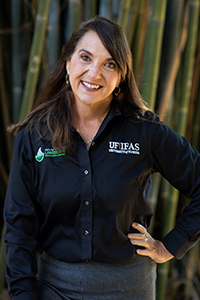Wendy's Wanderings
October 12, 2022
Party in the Back(yard)
I hope you are old enough to remember the mullet hair style. In the 1980s men and women opted to have short hair on the front part of their head and let the back hair grow long, and in the case of my college roommate, wild and curly. Back then we joked that it was "business in the front and party in the back." As unbelievable as it may seem this hairdo is making a comeback, especially with athletes and actors.
I think another place for the mullet style is your landscape. Over the years I have spoken to many homeowners that would love to have a wilder, non-traditional landscape. They feel they are limited by social norms and homeowner associations for what they can do in their front yard. Why not keep your landscape "business in the front" with standard landscaping and have a party in the back yard with a biodiverse, low-maintenance landscape?
Of course we would follow UF/IFAS recommendations for plant selection and care in both areas, but the backyard can be a refuge for birds, butterflies, pollinators, and have low inputs.
We strive to put the right plant in the right place, so consider your needs. If you have children and pets that need turfgrass in the backyard you could chose a turf that needs less fertilizer and irrigation like Bahiagrass. If you do not need turf in the backyard for recreation, consider using a native groundcover like sunshine mimosa, beach sunflower, or frog fruit. All of these are low growing, attractive to pollinators, and have low water needs.
If water conservation is a goal, cap irrigation heads and use mulched areas with drought-tolerant plants. Dr. Nick Taylor of UF/IFAS H20sav states that "a non-irrigated 1000 square foot area of landscape saves just over 300 gallons of water per irrigation compared to the average irrigation cycle." This could be a monthly savings of 2,500 gallons of water a month if you were watering that area two times a week. That's a lot of water.
Native plants and Florida-Friendly plants can be attractive to wildlife. With the consistent loss of natural habitat as Florida becomes more and more populated, planting native trees and vegetation can help support birds, insects, and other animals. Professor and author Dr. Doug Tallamy has identified certain native plant species as keystone plants. A keystone plant like an oak tree can support hundreds of types of caterpillars that are a food source for birds and other animals, not to mention the acorns. Broad pesticide applications aren't compatible with a landscape that is attracting wildlife, so the mullet backyard in a pesticide free zone.
For those that support the environment this type of landscape will promote the health and populations of our native plants and animals. Having a more biodiverse landscape can require less inputs of irrigation, fertilizer, and pesticides, and create a slice of the real Florida in your own backyard.
And remember, how you maintain the landscape is the key to keeping it Florida-Friendly. So even if you have a standard-looking front yard you don't have to overfertilize or overwater — following the Florida-Friendly Landscaping™ principles will keep it looking like business as usual.
-- Wendy Wilber

